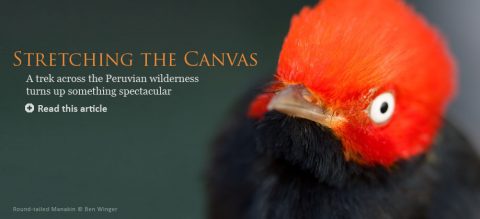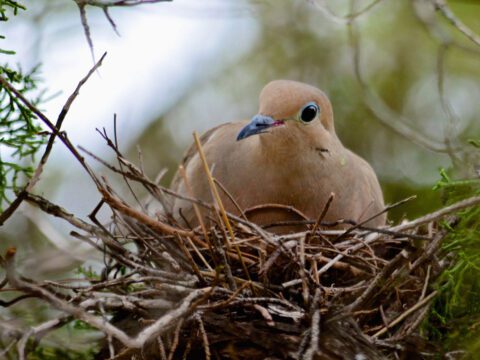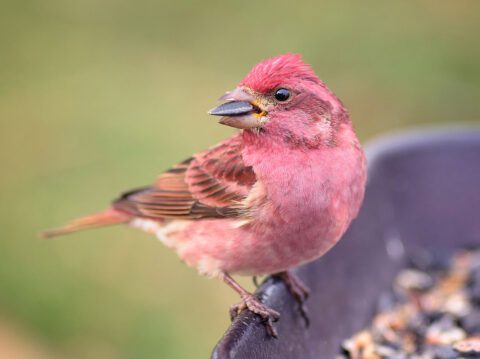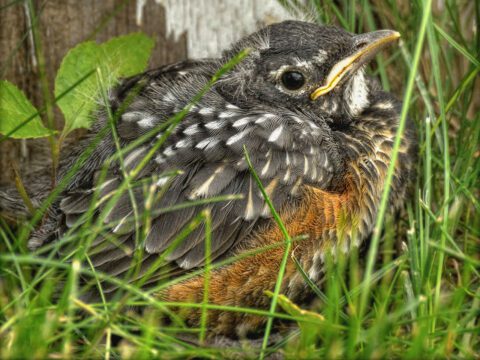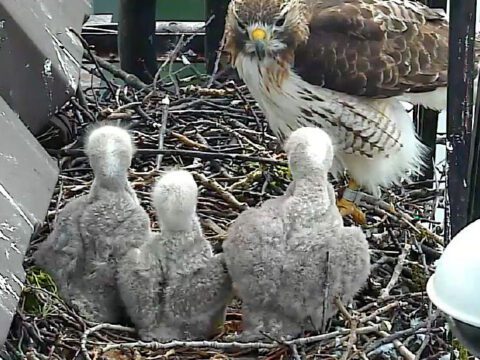A Feathered Tempest: The Improbable Life and Sudden Death of the Passenger Pigeon
by Stephen J. Bodio
April 15, 2010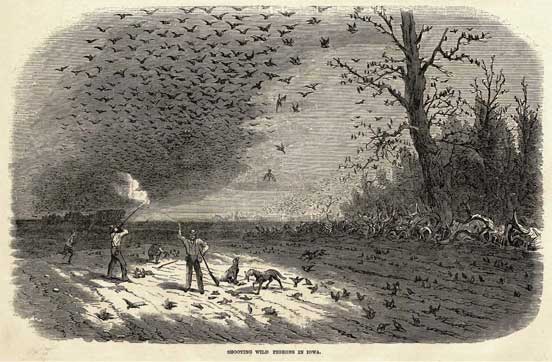
“The pigeon was a biological storm. He was the lightning that played between two opposing potentials of intolerable intensity: the fat of the land and the oxygen of the air. Yearly the feathered tempest roared up, down, and across the continent, sucking up the laden fruits of forest and prairie, burning them in a traveling blast of life. Like any other chain reaction, the pigeon could survive no diminution of his own furious intensity. When the pigeoners subtracted from his numbers, and the pioneers chopped gaps in the continuity of his fuel, his flame guttered out with hardly a sputter or even a wisp of smoke.” — Aldo Leopold
The Passenger Pigeon was not just a bird. Calling it a “biological storm,” as Aldo Leopold did, was an understatement; it was more like a series of simultaneous biological hurricanes, blowing all the time. Though its appearance was unremarkable, rather like a larger and more vividly colored Mourning Dove, it had habits like no other animal we have ever known. At its population’s peak, four to five billion pigeons roared over the forests and prairies of the East and Midwest, a number equal to the entire population of overwintering birds in the United States. A single flock in motion could darken the sky over 180 square miles, and take days to pass. One recorded breeding colony in Wisconsin in 1871 was 125 miles long and between six and eight miles wide. It covered most of the southern two-thirds of Wisconsin! A flock like this could consume an estimated 210 million liters of food a day.
Such a biological phenomenon could not have acted in a void. Modern ecological thinking shows us that if you subtract a species that once comprised 40 percent of all the birds in North America, you lose or change more than just a bird. Passenger Pigeons fed on enormous amounts of “mast,” the nuts produced by the then-dominant species of the eastern hardwood forest: white oak, beech, and chestnut. Of these, two are at least mildly in retreat today relative to other species, one seems to have fewer “crops,” and one is ecologically if not genetically extinct. Other species of plants also seem to be affected. Berries from no fewer than 11 families were dispersed by Passenger Pigeons, and some now rarely fall at any distance from their parent plant.
The pure physical effect of the flocks would have been like nothing that exists on the planet today, and perhaps since the days of the dinosaurs. The weight of the pigeons and their nests bore down on the forest like a hurricane, breaking limbs and even toppling trees. But no hurricane would also leave inches, even feet, of nitrogen-rich droppings on the forest floor. Contemporary observers said the ground looked “snow-covered” after the pigeons passed. The droppings first killed grasses and understory vegetation, then promoted riotous growth two or three years later.
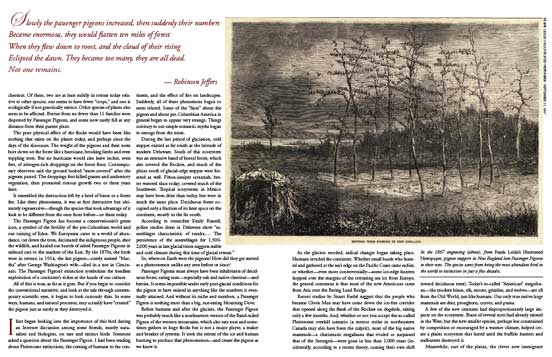
It resembled the destruction left by a herd of bison or a forest fire. Like these phenomena, it was at first destructive but ultimately regenerative—though the species that took advantage of it look to be different from the ones from before—or those today.
The Passenger Pigeon has become a conservationist’s green icon, a symbol of the fertility of the pre-Columbian world and our ruining of Eden. We Europeans came to a world of abundance, cut down the trees, decimated the indigenous people, shot the wildlife, and hauled out barrels of salted Passenger Pigeons in railroad cars to the markets of the East. By the 1870s, the birds were in retreat; in 1914, the last pigeon—cutely named “Martha” after George Washington’s wife—died in a zoo in Cincinnati. The Passenger Pigeon’s extinction symbolizes the heedless exploitation of a continent’s riches at the hands of our culture.
All of this is true, as far as it goes. But if you begin to consider the conventional narrative, and look at the tale through contemporary scientific eyes, it begins to look curiously thin. In some ways, humans, and natural processes, may actually have “created” the pigeon just as surely as they destroyed it.
I first began looking into the importance of this bird during an Internet discussion among some friends, mostly naturalists and biologists, on rare and extinct birds. Someone asked a question about the Passenger Pigeon. I had been reading about Pleistocene extinctions, the coming of humans to the continent, and the effect of fire on landscapes. Suddenly, all of these phenomena began to seem related. Some of the “facts” about the pigeon and about pre-Columbian America in general began to appear very strange. Things contrary to our simple romantic myths began to emerge from the mists.
During the last period of glaciation, cold steppes existed as far south as the latitude of modern Delaware. South of this ecosystem was an extensive band of boreal forest, which also covered the Rockies, and much of the plains south of glacial-edge steppes were forested as well. Piñon-juniper savannah, better watered than today, covered much of the Southwest. Tropical ecosystems in Mexico may have been drier than today, but were in much the same place. Deciduous forest occupied only a fraction of its later space on the continent, mostly in the far south.
According to researcher Emily Russell, pollen studies done in Delaware show “assemblages characteristic of tundra.… The persistence of the assemblages for 1,500-2,000 years in late glacial times suggests stable and cold climate during this time of glacial retreat.”
So, where on Earth were the pigeons? How did they get started as a phenomenon unlike any seen before or since?
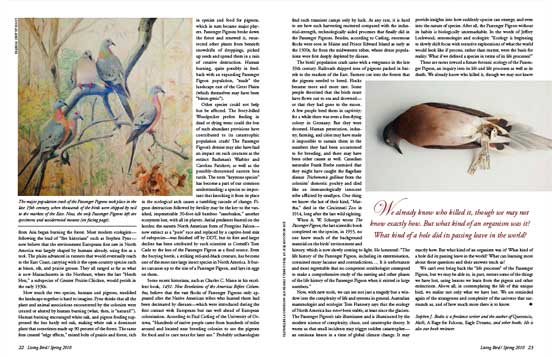
Passenger Pigeons must always have been inhabitants of deciduous forest, eating nuts—especially oak and native chestnut—and berries. It seems impossible under early post-glacial conditions for the pigeon to have existed in anything like the numbers it eventually attained. And without its niche and numbers, a Passenger Pigeon is nothing more than a big, nut-eating Mourning Dove.
Before humans and after the glaciers, the Passenger Pigeon was probably much like a southeastern version of the Band-tailed Pigeon of the western mountains, which also eats nuts and sometimes gathers in huge flocks but is not a major player, a maker and breaker of systems. It took the retreat of the ice and human burning to produce that phenomenon—and create the pigeon as we knew it.
As the glaciers receded, radical changes began taking place. Humans invaded the continent. Whether small bands who hunted and gathered at the sea’s edge on the Pacific Coast came earlier, or whether—even more controversially—some ice-edge hunters hopped over the margins of the retreating sea ice from Europe, the general consensus is that most of the new Americans came from Asia over the Bering Land Bridge.
Recent studies by Stuart Fiedel suggest that the people who became Clovis Man may have come down the ice-free corridor that opened along the flank of the Rockies on dogsleds, taking only a few months. And, whether or not you accept the so-called Pleistocene overkill scenario (a meteor strike in northeastern Canada may also have been the culprit), most of the big native mammals—a charismatic megafauna that rivaled or surpassed that of the Serengeti—were gone in less than 1,000 years (incidentally, according to a recent theory, causing their own shift toward deciduous trees). Today’s so-called “American” megafauna—the modern bison, elk, moose, grizzlies, and wolves—are all from the Old World, just like humans. Our only true native large mammals are deer, pronghorn, coyote, and puma.
A few of the new creatures had disproportionately large impacts on the ecosystem. Bison of several sorts had already existed in the West, but the new smaller species, perhaps less constrained by competition or encouraged by a warmer climate, helped create a plains ecosystem that lasted until the buffalo hunters and sodbusters destroyed it.
Meanwhile, east of the plains, the clever new immigrant from Asia began burning the forest. Most modern ecologists—following the lead of “fire historians” such as Stephen Pyne—now believe that the environment Europeans first saw in North America was largely shaped by humans already, using fire as a tool. The plains advanced in runners that would eventually reach to the East Coast, carrying with it the open-country species such as bison, elk, and prairie grouse. They all ranged as far as what is now Massachusetts in the Northeast, where the last “Heath Hen,” a subspecies of Greater Prairie-Chicken, would perish in the early 1930s.
How much the two species, humans and pigeons, modified the landscape together is hard to imagine. Pyne thinks that all the plant and animal associations encountered by the colonists were created or altered by human burning (what, then, is “natural?”). Human burning encouraged white oak, and pigeon feeding suppressed the less hardy red oak, making white oak a dominant plant that sometimes made up 90 percent of the forest. The same fires created “edge effects,” mixed belts of prairie and forest, rich in species and food for pigeons, which in turn became major players. Passenger Pigeons broke down the forest and renewed it, resurrected other plants from beneath snowdrifts of droppings, picked up seeds and spread them in a rain of creative destruction. Human burning, quite possibly in feedback with an expanding Passenger Pigeon population, “made” the landscape east of the Great Plains (which themselves may have been “bison-genic”).
Other species could not help but be affected. The Ivory-billed Woodpecker prefers feeding in dead or dying trees; could the loss of such abundant provisions have contributed to its catastrophic population crash? The Passenger Pigeon’s demise may also have had an impact on such creatures as the extinct Bachman’s Warbler and Carolina Parakeet, as well as the possibly-threatened eastern box turtle. The term “keystone species” has become a part of our common understanding: a species so important that knocking it from its place in the ecological arch causes a tumbling cascade of change. Pigeon destruction followed by fertility may be the key to the vanished, impenetrable 30-foot-tall bamboo “canebrakes,” another ecosystem lost, with all its players. Aerial predators feasted on the hordes; the eastern North American form of Peregrine Falcon—now extinct as a “pure” race and replaced by a captive-bred mix of subspecies—was finished off by DDT, but its first and larger decline has been attributed by such scientists as Cornell’s Tom Cade to the loss of the Passenger Pigeon as a food source. Even the burying beetle, a striking red-and-black creature, has become one of the most rare large insect species in North America. It buries carcasses up to the size of a Passenger Pigeon, and lays its eggs on them.
Some recent historians, such as Charles C. Mann in his excellent book, 1491: New Revelations of the Americas Before Columbus, believe that the vast flocks of Passenger Pigeons only appeared after the Native American tribes who hunted them had been decimated by diseases—which were introduced during the first contact with Europeans but ran well ahead of European colonization. According to Paul Catling of the University of Ottawa, “Hundreds of native people came from hundreds of miles around and located near breeding colonies to use the pigeons for food and to cure meat for later use.” Probably archaeologists find such transient camps only by luck. At any rate, it is hard to see how such harvesting mattered compared with the industrial- strength, technologically aided processes that finally did in the Passenger Pigeons. Besides, according to Catling, enormous flocks were seen in Maine and Prince Edward Island as early as the 1500s, far from the midwestern tribes, whose dense populations were first deeply depleted by disease.
The birds’ population crash came with a vengeance in the late 19th century. Railroads shipped tons of pigeons packed in barrels to the markets of the East. Farmers cut into the forests that the pigeons needed to breed. Flocks became more and more rare. Some people theorized that the birds must have flown out to sea and drowned—or that they had gone to the moon. A few people bred them in captivity; for a while there was even a free-flying colony in Germany. But they were doomed. Human persecution, industry, farming, and cities may have made it impossible to sustain them in the numbers they had been accustomed to for breeding, and there may have been other causes as well. Canadian naturalist Frank Beebe surmised that they might have caught the flagellate disease Trichomonis gallinae from the colonists’ domestic poultry and died like an immunologically innocent tribe afflicted by smallpox. One thing we know: the last of their kind, “Martha,” died in the Cincinnati Zoo in 1914, long after the last wild sighting.
When A. W. Schorger wrote The Passenger Pigeon, the last scientific book completed on the species, in 1955, no one knew much of the background material on the birds’ environment and history, which is now slowly coming to light. He lamented: “The life history of the Passenger Pigeon, including its extermination, contained many lacunae and contradictions.… It is unfortunate and most regrettable that no competent ornithologist attempted to make a comprehensive study of the nesting and other phases of the life history of the Passenger Pigeon when it existed in large numbers.”
Now, with new tools, we can see not just a tragedy but a window into the complexity of life and systems in general. Australian mammalogist and ecologist Tom Flannery says that the ecology of North America has never been stable, at least since the glaciers. The Passenger Pigeon’s tale illuminates and is illuminated by the modern science of complexity, chaos, and catastrophe theory. It warns us that small incidents may trigger sudden catastrophes—an ominous lesson in a time of global climate change. It may provide insights into how suddenly species can emerge, and even into the nature of species. After all, the Passenger Pigeon without its habits is biologically unremarkable. In the words of Jeffrey Lockwood, entomologist and ecologist: “Ecology is beginning to slowly shift focus with tentative explorations of what the world would look like if process, rather than matter, were the basis for reality. What if we defined a species in terms of its life processes?” These are notes toward a future forensic ecology of the Passenger Pigeon, an inquiry into its life and life processes as well as its death. We already know who killed it, though we may not know exactly how. But what kind of an organism was it? What kind of a hole did its passing leave in the world? What can learning more about these questions and their answers teach us?
We can’t ever bring back the “life processes” of the Passenger Pigeon, but we may be able to, in part, restore some of the things we have lost, using lessons we learn from the pigeon and other extinctions. Above all, in contemplating the life of this unique bird, we realize not only what we have lost. We are reminded again of the strangeness and complexity of the universe that surrounds us, and of how much more there is to know.
Stephen J. Bodio is a freelance writer and the author of Querencia, Aloft, A Rage for Falcons, Eagle Dreams, and other books. He is also our book reviewer.

All About Birds
is a free resource
Available for everyone,
funded by donors like you
American Kestrel by Blair Dudeck / Macaulay Library
